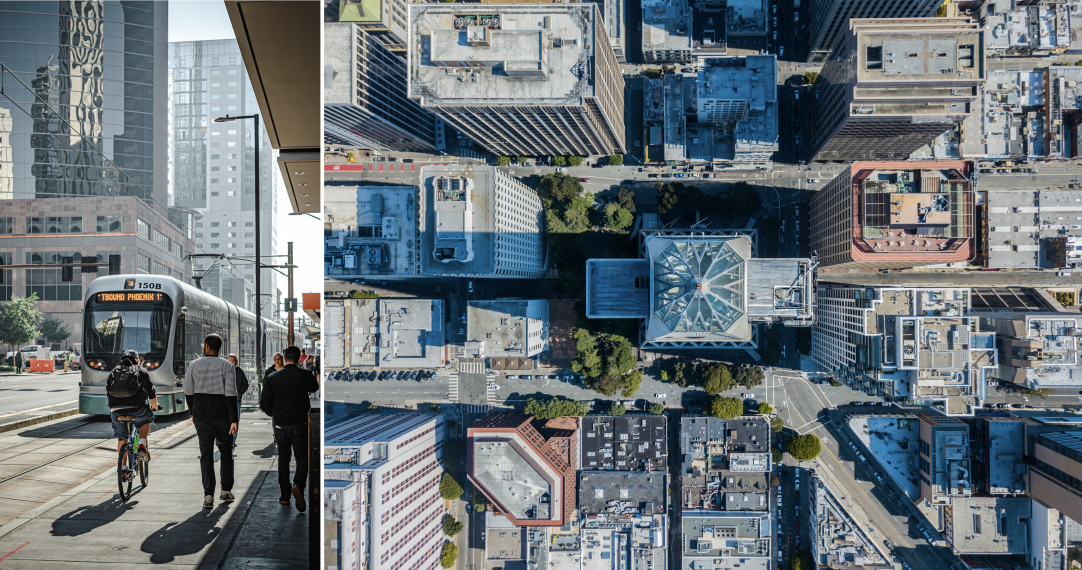Cooling Infrastructure Helps Control Pedestrian-Level Air Temperatures in Urban Areas

What do you need to know?
Cities are often warmer compared to rural areas due to various reasons, including reduced reflectivity and lack of water retention of urban surfaces. With climate change, the difference between urban and rural areas is expected to become even more pronounced. These increasingly warmer air temperatures in urban environments can have negative impacts on human health, air quality and thermal comfort. Therefore, implementing cooling infrastructure in urban areas is an important aspect in ensuring urban climates are safe for humans during summer months.
Increasing the number of reflective roofs on buildings is an effective method to regulate local climate conditions during heatwave conditions. Reflective roofs can decrease temperatures by approximately 0.1 to 2°C. This study confirmed that reflective roofs were responsible for lowering pedestrian-level air temperatures in Phoenix, Atlanta and Detroit. In terms of cooling effectiveness, reflective roofs in Phoenix are projected to cause the largest decrease in pedestrian-level air temperature. As climate change increases summer temperatures in urban areas, newly developed infrastructure should incorporate reflective roofs in regions where winter and shoulder season disbenefits are small.
Why is this research important?
Temperatures in urban areas are projected to increase due to climate change. Warmer air temperatures and heat waves don’t simply lead to discomfort but can be a serious threat to human health, as these temperatures can lead to heat stress and even death. As the global population increases, more and more people are projected to live in urban environments, making the implementation of cooling infrastructure necessary to help mitigate the negative effects of a warming climate.
Knowledge of the impacts of high temperatures in urban areas can allow for cities experiencing high temperatures to adapt to the warming climate, as well as help guide urban planners and policy makers towards implementing cooling infrastructure in new urban environments and in pre-existing urban areas.
What did the researchers do?
This experiment assessed the cooling ability of cool roofs for Atlanta, Detroit and Phoenix during 90thpercentile (i.e., extreme) heatwaves for each of three 30-year time periods (1981-2010, 2041-2070 and 2041-2070). These heatwaves were simulated with a regional climate model (WRF). This regional climate model can simulate current climate and future climate events, when provided boundary conditions from a global climate model (the CESM model, in this case). The objectives of this research were as follows:
- To assess the intensity of heatwave temperatures by modelling the projected heatwave conditions for each of the three cities for each time period;
- To evaluate the ability of uniform, high intensity cool roof application across each city to offset projected air temperature increases during contemporary and projected heat waves.
Simulations also accounted for roof area, building height and spacing between buildings to account for the specific impacts of urbanization on local climate.
What did the researchers find?
The most important results from this study were:
- Future heatwave severity is expected to increase in all 3 cities. A smaller increase in temperatures is expected in Phoenix, compared to the larger increases in Atlanta and Detroit;
- Cooling impacts of cool roofs are expected to be more significant during the day and minimal at night;
- Daily maximum temperature changes (11 am – 2 pm) in Phoenix are found to be −2.5 °C, and −2.0 °C in Atlanta and Detroit during the simulated heat waves after implementing cool roofs;
- Cool roofs in Phoenix are 11% more effective at cooling pedestrian-level air temperature than in Atlanta, and 30% more effective than in Detroit;
- Low-density areas may experience more intense cooling per unit of albedo increase compared to medium and high-density urban areas. Cool air from roofs is expected to impact suburban areas at the downwind edges of the city more than at the upwind edges of the city;
- Cool roofs will generally be more effective at cooling pedestrian air temperature in the Sunbelt than the Midwest and Northern regions of the US.
About the researchers
Dr. Scott Krayenhoff is an Assistant Professor at the School of Environmental Sciences, University of Guelph. Dr. Matei Georgescu is an Associate Professor and Dr. Ashley Broadbent is a Research Assistant Professor, both at Arizona State University.
Keywords
Heatwaves, pedestrian air temperature, urbanization, climate change, urban planning, cooling technologies, cool roofs
Citations
Broadbent, A. M., Krayenhoff, E. S., & Georgescu, M. (2020). Efficacy of cool roofs at reducing pedestrian-level air temperature during projected 21st century heatwaves in Atlanta, Detroit, and Phoenix (USA). Environmental Research Letters, 15(8), 084007.
https://iopscience.iop.org/article/10.1088/1748-9326/ab6a23/meta